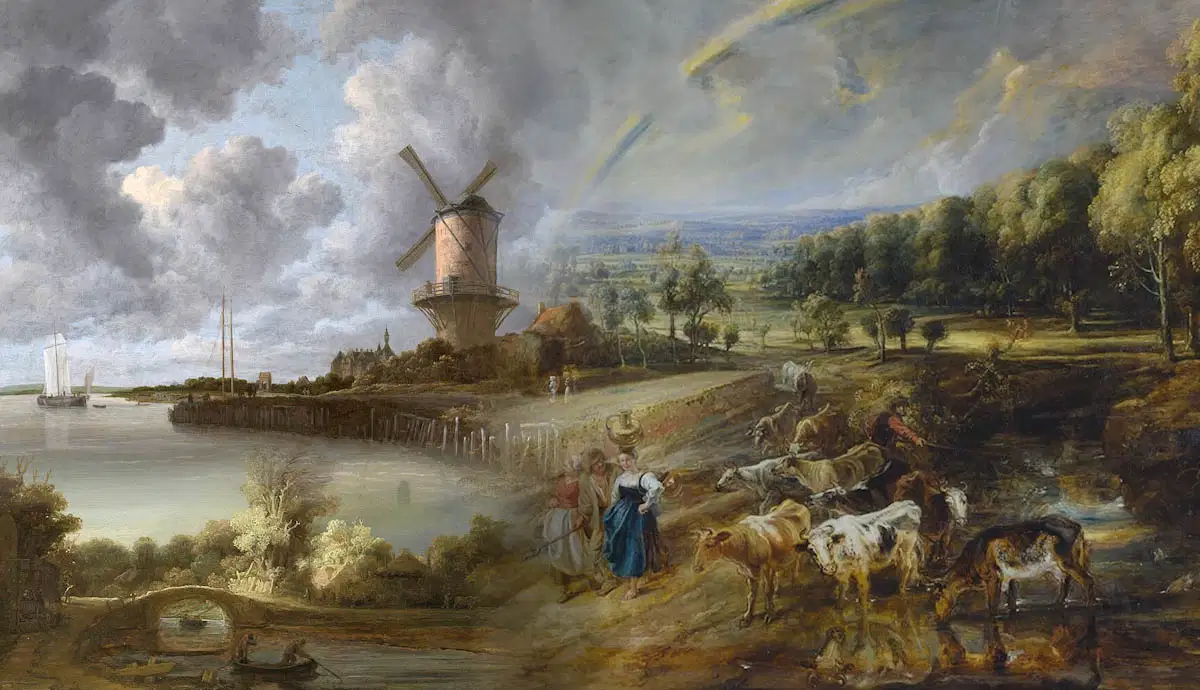Art history is rich with influential movements and revolutionary figures, but few nations have produced as many iconic and influential artists as the Netherlands. Dutch artists have consistently left an indelible mark on the world, producing works that have not only stood the test of time but also shaped the very fabric of art history. These Dutch artists famous for their contributions have redefined artistic expression, capturing the essence of their time while speaking to universal human experiences. In this article, we’ll explore 10 powerful creations by Dutch artists that continue to resonate and inspire.
The Night Watch by Rembrandt van Rijn
Rembrandt van Rijn is a name synonymous with Dutch art, and his painting The Night Watch is one of his most celebrated works. This masterpiece, created in 1642, stands out for its dramatic use of light and shadow, a technique Rembrandt perfected and became known for. Depicting a group of civic guardsmen, the painting is not just a portrait but a vivid narrative scene that captures a moment of action. Rembrandt’s innovative composition and mastery of chiaroscuro make The Night Watch a quintessential example of why Dutch artists famous for their technique have influenced generations of painters.
Girl with a Pearl Earring by Johannes Vermeer
One of the most iconic paintings of all time, Girl with a Pearl Earring, was created by Johannes Vermeer in 1665. This painting, often referred to as the “Mona Lisa of the North,” exemplifies Vermeer’s ability to portray quiet, intimate moments with remarkable depth and clarity. The subject’s gaze, the soft play of light on her face, and the enigmatic pearl earring have captivated viewers for centuries. Vermeer’s mastery of light and composition has cemented his place among the Dutch artists famous for their subtle yet profound works.
Starry Night Over the Rhone by Vincent van Gogh
Vincent van Gogh’s turbulent life and emotional intensity are reflected in his vibrant, swirling compositions, with Starry Night Over the Rhone being one of his most poignant works. Painted in 1888, this piece captures the beauty and tranquility of a night sky over a river in Arles, France. The juxtaposition of the calm, shimmering water with the bold, swirling sky is a hallmark of Van Gogh’s style. Van Gogh, among Dutch artists famous for their emotional expressionism, used color and brushstrokes to convey feelings rather than reality, creating art that resonates deeply with viewers.
The Hay Wagon by Hieronymus Bosch
Hieronymus Bosch is one of the most enigmatic figures in Dutch art. His triptych The Hay Wagon, painted around 1516, is a prime example of his surreal and symbolic approach to storytelling. The central panel depicts a massive wagon of hay being pulled through a chaotic scene filled with figures engaged in various vices. Bosch’s fantastical and often grotesque imagery set him apart from his contemporaries, earning him a unique place among Dutch artists famous for their visionary and allegorical work. His influence can still be seen in the world of surrealism and contemporary art today.
The Milkmaid by Johannes Vermeer
Another masterpiece by Johannes Vermeer, The Milkmaid (circa 1658), showcases his extraordinary ability to capture everyday scenes with meticulous detail and serene beauty. The painting depicts a domestic scene of a young woman pouring milk, yet the stillness and dignity imbued in the simple act make it timeless. Vermeer’s use of light, texture, and color elevates a mundane task into something deeply poetic, underscoring why he is one of the Dutch artists famous for his portrayal of quiet, intimate moments.
Self-Portrait with Two Circles by Rembrandt van Rijn
Rembrandt created numerous self-portraits throughout his life, but Self-Portrait with Two Circles (circa 1665-1669) stands out as one of his most striking. This late-career painting shows the artist with his tools, standing confidently before a blank canvas with two mysterious circles in the background. The intense gaze and rich, textured brushwork reflect Rembrandt’s self-assurance as well as his contemplative nature. Among Dutch artists famous for their introspective works, Rembrandt’s self-portraits are unmatched in their psychological depth and technical brilliance.
The Arnolfini Portrait by Jan van Eyck
Though Jan van Eyck is technically considered part of the early Netherlandish school, his influence on Dutch art is undeniable. The Arnolfini Portrait (1434) is one of his most celebrated works, showcasing his mastery of oil painting and attention to detail. The painting is filled with symbolic elements, from the mirror reflecting the couple to the small dog symbolizing loyalty. Van Eyck’s meticulous technique and ability to capture texture and light with such precision have earned him a place among Dutch artists famous for their realism and innovation in the use of oil paint.
The Scream by Edvard Munch
Though Edvard Munch was Norwegian, his work had significant connections with Dutch expressionist influences, particularly in its emotional intensity. The Scream (1893), though often associated with Nordic angst, shares thematic and stylistic traits with Dutch post-impressionism, particularly in its use of vivid colors and swirling forms. Munch’s ability to convey existential terror and isolation through simple, bold imagery makes The Scream a timeless piece, often linked to the emotional expression of Dutch artists famous for their psychological depth and intensity.
The Merry Family by Jan Steen
Jan Steen’s genre paintings are known for their humor, liveliness, and moral messages. The Merry Family (1668) is one of his most famous works, depicting a boisterous family celebration. Steen often used his art to comment on human behavior, and this painting is no exception, humorously warning about the perils of excess and indulgence. The chaotic energy, vibrant color palette, and detailed expressions in the painting reflect Steen’s keen observational skills. His ability to combine moral lessons with entertainment has ensured his place among Dutch artists famous for their lively and satirical scenes of daily life.
The Garden of Earthly Delights by Hieronymus Bosch
One of the most extraordinary works in art history, The Garden of Earthly Delights (circa 1490-1510) by Hieronymus Bosch, is a surreal triptych that explores themes of sin, pleasure, and consequence. The left panel represents the Garden of Eden, the central panel shows a fantastical world of hedonistic pleasures, and the right panel depicts a nightmarish Hell. Bosch’s imaginative and complex vision, filled with bizarre creatures and intricate details, has fascinated viewers for centuries. His unique style and symbolic approach to storytelling make him one of the Dutch artists famous for pushing the boundaries of art and perception.
Conclusion
The enduring legacy of these Dutch artists is a testament to their innovation, technical mastery, and the emotional depth of their work. Whether through Rembrandt’s exploration of light and shadow, Vermeer’s quiet intimacy, or Van Gogh’s vibrant emotionalism, these artists have captured the human experience in ways that continue to resonate across generations. Their masterpieces are not just historical artifacts but living works of art that continue to inspire and challenge us. The creativity and vision of these Dutch artists famous for their contributions to art history ensure their place in the annals of cultural heritage, standing the test of time.
FAQs
Q1. What makes Dutch artists famous?
Dutch artists are renowned for their innovation in techniques like chiaroscuro (light and shadow), use of color, and attention to detail. They are also famous for their ability to capture both the grandeur and the simplicity of everyday life, as well as their mastery of genres ranging from portraiture to landscape painting.
Q2. Why is Rembrandt so highly regarded?
Rembrandt is considered one of the greatest Dutch artists famous for his ability to portray human emotion with incredible depth and realism. His innovative use of light and shadow, combined with his masterful technique in portraiture and narrative art, has made him a pivotal figure in art history.
Q3. How did Vermeer contribute to Dutch art?
Vermeer contributed to Dutch art by perfecting the depiction of light and texture in his works. His intimate portrayals of domestic life, with an almost photographic realism, have made him one of the Dutch artists famous for capturing quiet beauty and stillness in everyday moments.
Q4. What was unique about Hieronymus Bosch’s art?
Hieronymus Bosch’s art is unique for its surreal and fantastical elements. His works are filled with symbolic imagery, bizarre creatures, and detailed scenes that often convey moral lessons, making him one of the famous Dutch artists for his visionary and allegorical approach to storytelling.
Q5. How did Van Gogh revolutionize art?
Vincent van Gogh revolutionized art by using bold colors and expressive brushstrokes to convey emotional and psychological depth. His unique style, which departed from realistic representation, has made him one of the famous Dutch artists for influencing modern art movements like expressionism and post-impressionism.
Also read: Amsterdam Netherlands Flag: 10 Incredible Insights Into Its Rich Heritage





